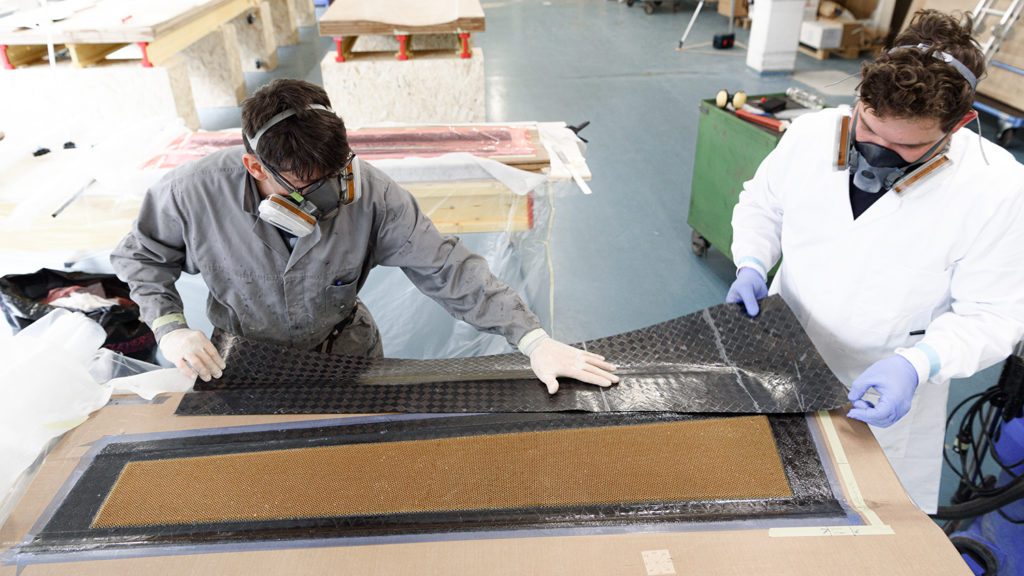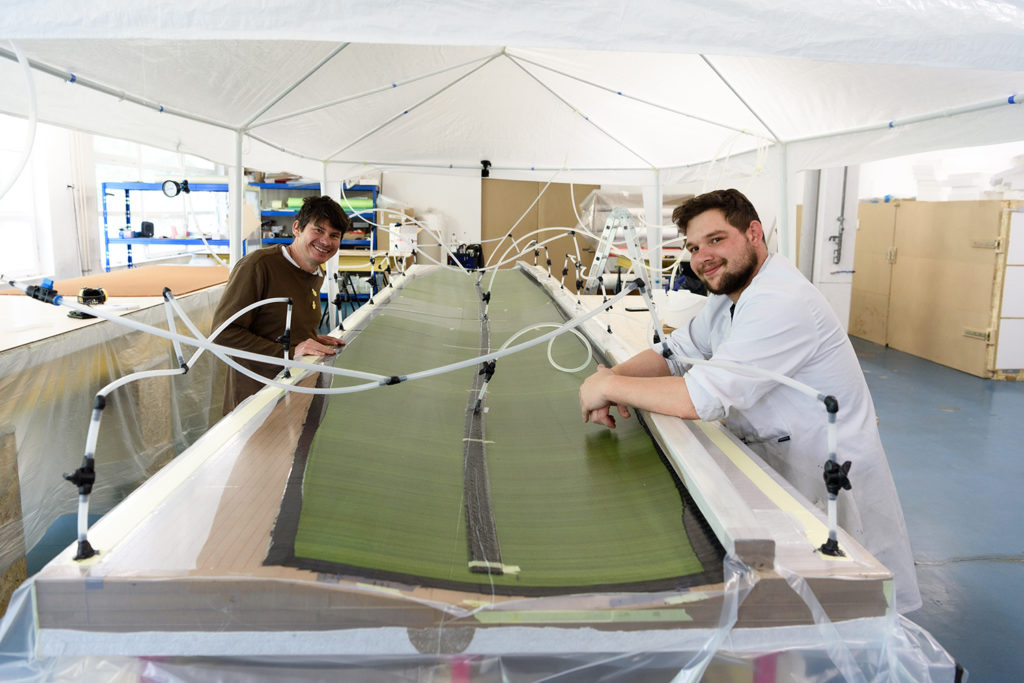This site uses cookies so that we can provide you with the best possible user experience. The information about cookies is stored in your browser and performs functions such as recognizing you when you return to our website and helping our team understand the sections of the site that you find most interesting and useful.
24.06.2021
Behind the scenes: Manufacturing
The design of the UR-1 all-electric race plane is the result of a sophisticated engineering project. Once designed, the challenging task of production begins.
During the parts production, the manufacturers, e.g. our composite technicians, keep in close contact with the mechanical design engineers in order to guarantee the respect of every detail and, thus, build a safe aircraft.
This incessant discussion concerns fabrication techniques, tools and materials available or simply measurement. All the steps between the design process and the production of aircraft parts are fully interconnected and communication plays a strategic role when it comes to changes and improvements, especially in an experimental project such as ours.
At Pie Aeronefs SA, in the production process of the UR-1 electric aircraft parts, we have to take into account a complicated system of pressure, strength, flexibility and weight. Every single component and action, like mixing resins, requires the respect of strict rules including a safety margin.
Have a glimpse behind the scenes of the parts production for our Swiss all-electric aircraft.
First steps
After receiving a preliminary design, the manufacturers, e.g. in composite materials, and the mechanical design engineers discuss together about all the possible options they have in terms of tooling and fabrication techniques. This first phase is crucial for refining the design on the CAD (Computer Aided Design) and making strategic changes if needed, such as the dimensions of some parts, for example.
That is why the communication between the team is so important. Indeed, the selection of the right materials for producing a UR-1 aircraft part often depends on its geometry as well as on the strength required by the stress analysts. This latest point will allow to establish how many layers and/or plies are required at which exact place.
All these factors represent the result of a solid teamwork that equates theory and reality (nuts and bolts, in the jargon). To give you more insights on this preparation stage, during the design study of the ailerons (first parts of the UR-1 manufactured), the teams discussed thoroughly about the best solution to adopt to produce it: full foam core with a carbon skin on the surface, or hollow mold inside with a top and bottom skin manufactured with an honeycomb core and ribs.

Most of the time, it is not possible to build a part in “one shot” even when it is made of a single material type. A typical example is our wingspar. Made of carbon fiber, it will consist of up to 100 layers stacked together. When the epoxy resin does polymerize, it creates heat. Because of this reaction, we need to make our spar in 3 steps in order to guarantee its quality.
Tools and timeline
Almost every part of the UR-1 Swiss electric aircraft is made in-house. In order to create such parts, particularly the one in composite, we need to create molds. For this matter, we mainly use MDF (Medium Density Fiber) wood, which is a panel made of small fiber or wood dust mixed with glue and shaped with different sizes and thicknesses. This kind of material is well suited to manufacture the shape we would like to obtain, as it is easy to machine from a big block with our CNC machine.
Concerning the lamination process, we decided to adopt two different approaches. In some cases, we opt for a wet laminate technique and in some other cases for an infusion technique.

The outer layers of the carbon fiber wing have been infused with resin through these numerous pipes. 
The wet process consists of the resin impregnation directly on the carbon fiber before placing it in the mold.
The infusion is well suited for impregnating outer layers and having a better finish but is not suited for local lamination or small parts. On the other side, the wet laminate offers us the possibility to do local work or work over honeycomb inserts, as we don’t want to fill them with resin.
In the future, we will most probably change for a prepreg technique: an already wetted layer that allows for more precise work
The time it takes to produce a single part of the UR-1 aircraft naturally depends on its complexity: a simple panel may be built in six or seven hours and manufacturing a wing requires many weeks.
It is worthwhile to specify that the design and the production of a part is always a compromise between theory and reality. In other words, you can have the ideal theoretical weight, incl. safety margins, which the engineers feel comfortable with, and some manufacturing peculiarities that lead to a final weight discrepancy to be corrected.
Failure culture
During the parts production procedure, it can sometimes happen to notice some discrepancies between drawings and reality: it’s normal!
Making parts for the first Swiss all-electric race aircraft is a complicated work in which every variable has its influence. In that sense, making mistakes and oversights can happen and they are an opportunity for us to learn and also improve our skills and for the project to move ahead.
In order to detect any failure or defect, we, at Pie Aeronefs SA, already have an efficient checking system consisting of accurate, standardized and sophisticated tests.
You will learn more about our checking procedures in an upcoming behind-the-scenes article of Pie Aeronefs SA.
Interview
In this interview, our expert in composite materials Fabrice Allaz offers you a personal opinion on his work.
